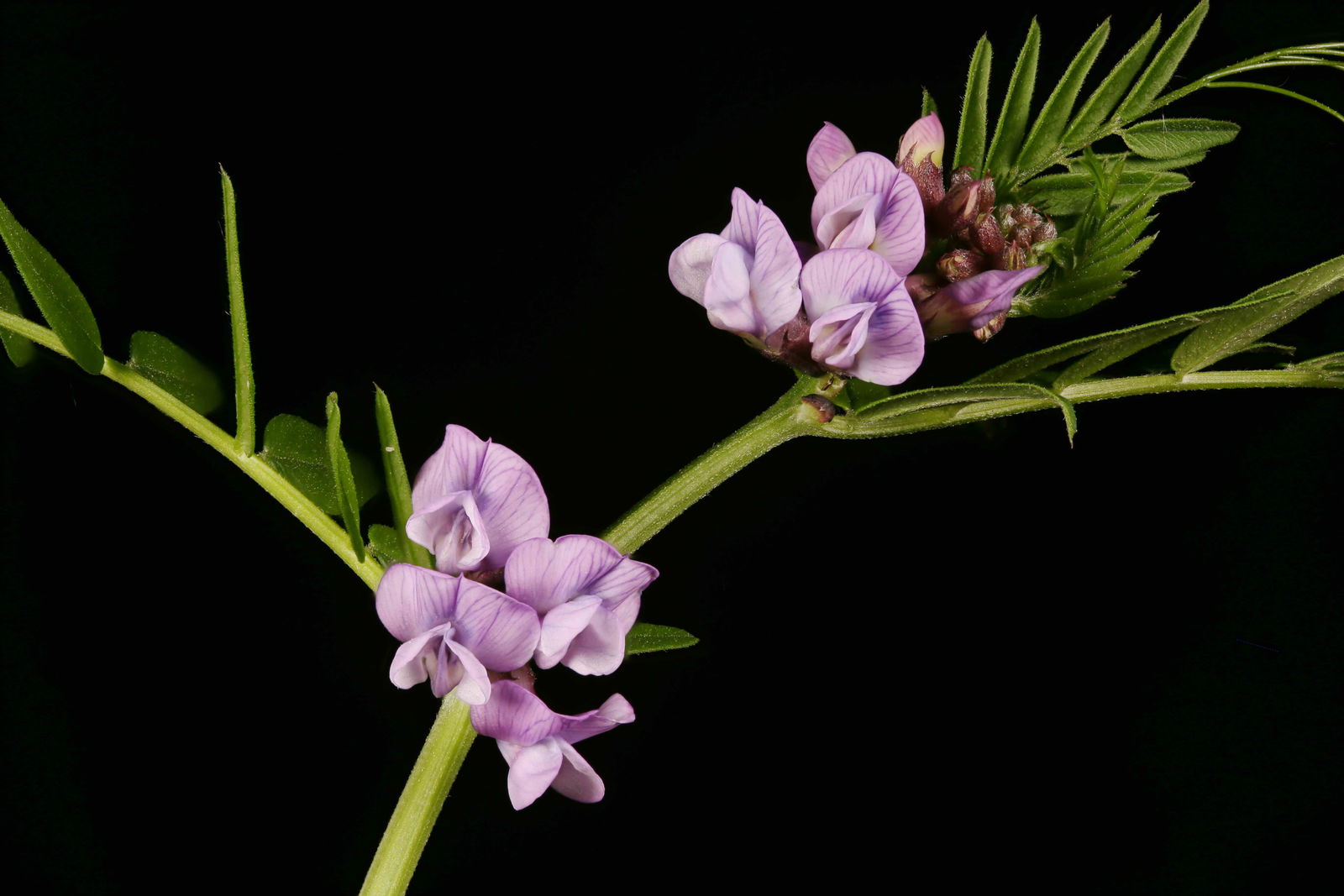Bush Vetch
vicia sepium
Also known as: ["Wood Vetch","Shrub Vetch"]
Overview
A climbing or trailing perennial legume with compound leaves and purple or pinkish flowers, native to Europe and Asia.
Benefits & Perks
["wildlife attractant (bees, butterflies, birds)","low maintenance"]
Botanical Classification
| Phylum: | Magnoliophyta |
| Class: | Magnoliopsida |
| Order: | Fabales |
| Family: | Fabaceae |
| Genus: | Vicia |
| Botanical Name: | Vicia sepium |
Plant Characteristics
Basic Information
- Category: Flowers
- Suitable Location: garden border, woodland edge, or naturalized area
- Suitable For:
- Is Weed: No
- Allergenicity: low
Environmental Needs
- Climate: {"temperatureRange":"5–30°C"}
- Hardiness: {"zones":"3–8"}
- Misting: rarely required, only if ambient humidity is very low
- Drainage: Well-draining but moisture-retentive.
- Soil Type: Rich, loamy soil with good organic matter.
Maintenance Level
- Maintenance Level: moderate
- Toughness Level: moderate
- Pruning Frequency: Annually in late winter or early spring; light pruning can be done as needed.
- Pruning Intensity: Moderate; remove up to one-third of growth if necessary.
Care Details
Ideal Sunlight Coverage:
Full sun to partial shade; 6–8 hours of direct sunlight daily, with some afternoon shade in hot climates.
Sunlight Tolerance Tips:
Acclimate plants gradually to intense sunlight; protect from harsh afternoon sun; adjust placement based on seasonal light changes.
Care Requirements
Care Difficulty
easymoderate
Sunlight
partial shade to full sun
Rotate plants for even light exposure; use shade cloth in extreme heat; monitor for sunburn.
Watering
every 7–10 days during active growth, reduce in winter
Water thoroughly but infrequently; ensure good drainage; avoid wetting foliage.
Soil
well-drained, loamy soil with moderate organic content
pH: Slightly acidic to neutral, pH 6.0–7.0.
Ensure soil is not waterlogged; amend with organic matter; test pH periodically.
Temperature
Prefers cool to moderate temperatures, 60–75°F (15–24°C); tolerates cooler nights.
Avoid sudden temperature shifts; protect from frost; ensure good air circulation.
Fertilizing
every 4–6 weeks during growing season
Apply fertilizer after watering; stop feeding in dormant periods; flush soil occasionally to prevent salt buildup.
Propagation
Methods
Stem cuttings or seed sowing.
Step-by-Step Propagation Guide
- Take cuttings.
- Apply rooting hormone.
- Plant in medium.
- Maintain humidity.
- Transplant when rooted.
Best Time: Spring or early summer when growth is active.
Environment
Warm, humid environment with indirect light.
Medium
Well-draining potting mix with perlite or sand.
Hormone
Optional, but rooting hormone can improve success rates.
Timeline
Roots develop in 3–6 weeks; establish in 2–3 months.
Tools Needed
Pruners, rooting hormone, pots, misting spray bottle.
Quick Tips
Use healthy, non-flowering stems; maintain consistent moisture; provide bottom heat if possible.
Pruning & Repotting
Pruning Guide
Method
Pinch back tips for bushiness; cut back leggy stems to encourage branching.
Pruning Plan
Prune to maintain shape, encourage bushiness, and remove dead or diseased growth.
Tools
Pruning shears, sharp knife, gloves.
Checklist
Sterilize tools; prune during dormancy; remove dead/diseased parts; shape as desired.
Repotting Guide
Best Season
Early spring before new growth begins.
Pot Size
Increase pot size by 2–3 inches in diameter.
Method
Use fresh potting mix; ensure good drainage; gently tease out crowded roots.
Suggestions
Repot every 2–3 years or when roots fill the pot; beneficial for container-grown plants.
Checklist
Check root bound status; prepare new pot; use fresh soil; water after repotting.
Advanced Care Tips
Watering Mastery
Watering Checklist
Check soil moisture; water deeply; ensure drainage; avoid wetting leaves.
How to Apply Water Properly
Water at the base of the plant, ensuring moisture reaches the root zone; allow excess water to drain away; water in the morning to reduce evaporation.
Watering Schedule Tips
Water deeply once the top inch of soil feels dry; reduce frequency in winter to prevent root rot.
Soil Improvement
Add compost or well-rotted manure; incorporate perlite for drainage; use mulch to retain moisture.
Temperature Stress Management
Signs of Temperature Issues
Wilting, yellowing leaves, or stunted growth in extreme heat or cold.
Cold Stress
Slows growth, may cause leaf drop, or dormancy in prolonged cold.
Solution: Provide frost protection; move potted plants indoors; use mulch to insulate roots.
Hot Stress
Leaves may scorch, wilt, or drop; reduced flowering in excessive heat.
Solution: Provide shade during peak sun; increase watering; use mulch to retain moisture.
Fertilizing Guide
Fertilizing Checklist
Check fertilizer type; dilute correctly; apply during active growth; avoid winter feeding.
Fertilizing Method
Use balanced liquid fertilizer diluted to half strength every 4–6 weeks during growing season; avoid fertilizing in winter.
Common Problems & Solutions
Toxicity Warning
Cats
Slightly ToxicCats may experience mild gastrointestinal irritation if they consume the seeds of Vicia sepium. The alkaloids present can lead to digestive discomfort, though severe toxicity is rare.
⚠️ Symptoms:
🌿 Toxic Parts:
⚡ Toxic If:
if eaten
Dogs
Slightly ToxicThe seeds of Vicia sepium can cause mild gastrointestinal upset in dogs due to the presence of alkaloids. The effects are typically not severe but can cause discomfort.
⚠️ Symptoms:
🌿 Toxic Parts:
⚡ Toxic If:
if eaten
Humans
Slightly ToxicVicia sepium, commonly known as bitter vetch, contains alkaloids that can cause mild gastrointestinal distress when ingested in significant quantities. The physiological impact is generally limited to irritation of the digestive tract.
⚠️ Symptoms:
🌿 Toxic Parts:
⚡ Toxic If:
if eaten
Frequently Asked Questions
Q: Is Vicia sepium toxic to pets?
A: Yes, it is mildly toxic to dogs and cats.
Q: Does Bush Vetch attract wildlife?
A: Yes, it attracts bees, butterflies, and birds.
Q: How difficult is it to care for Vicia sepium?
A: It is relatively easy to care for with moderate maintenance needs.
Quick Reference
| Family: | Fabaceae |
| Care: | easy |
| Light: | partial shade to full sun |
| Water: | every 7–10 days during activ |
Get Expert Care Tips
Download the Plantious app for personalized care reminders and plant identification!
Google Play App Store








